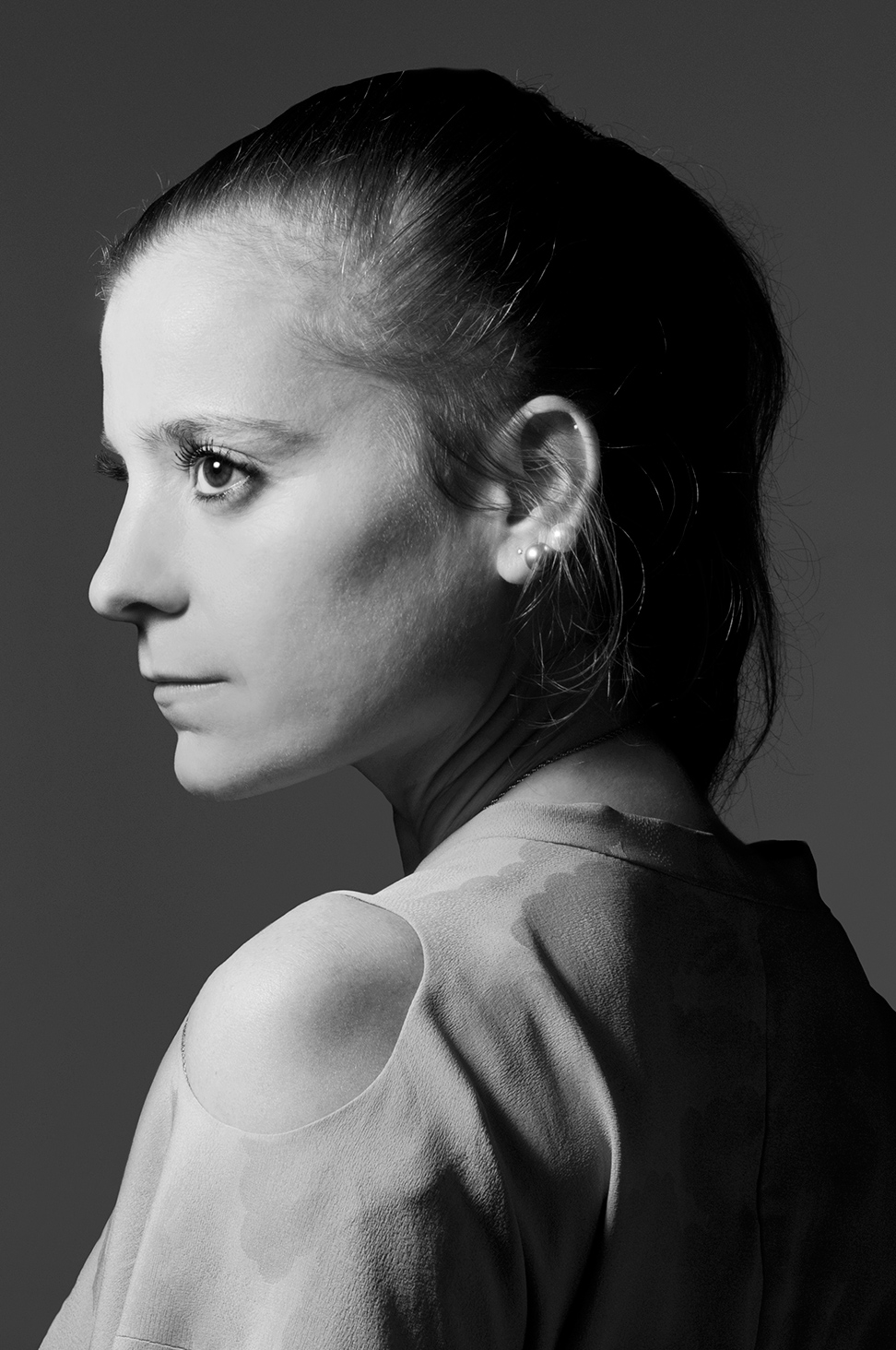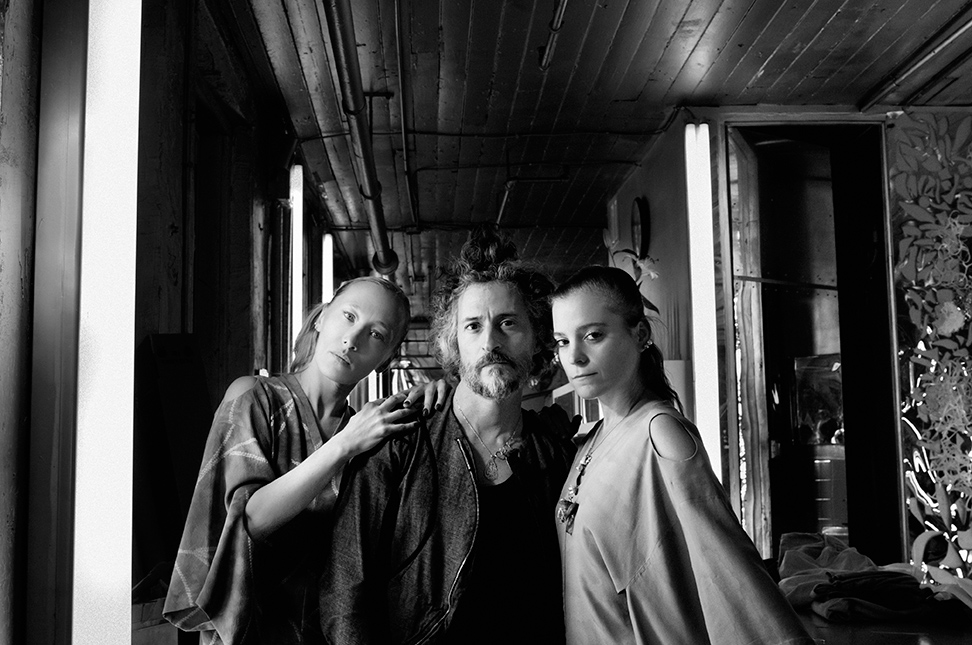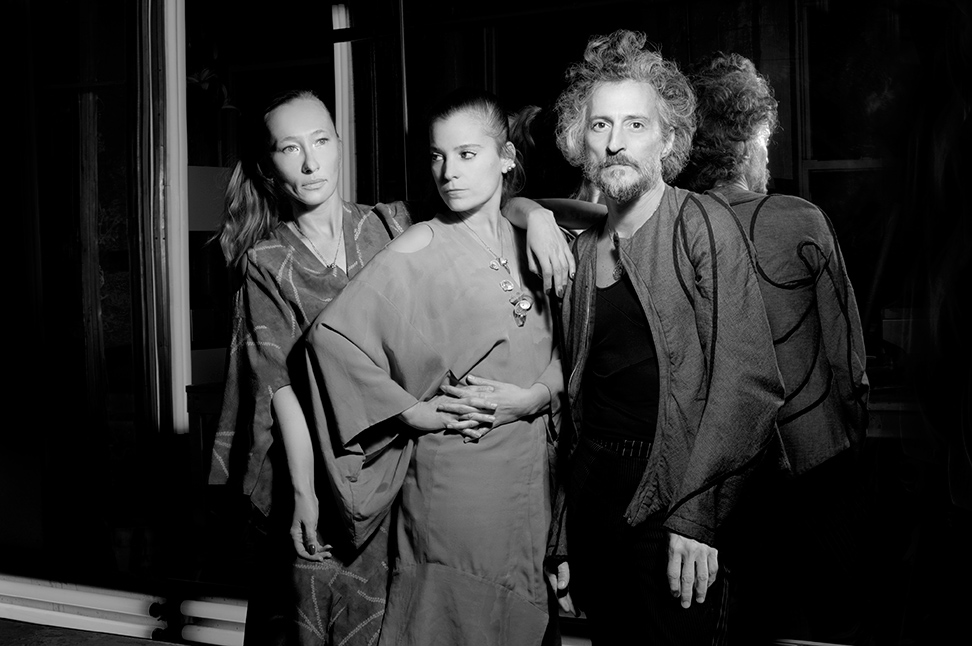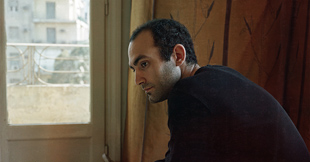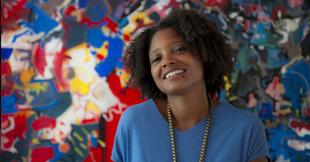
Interviewed by Amy Routman
Photographed by Therese + Joel
If fashion shows the temper of the moment– reflecting the concerns and the ambitions of the age – then threeASFOUR holds a mirror up to our communal psyche. Their concept magnifies the issues of multicultural living, technology, craft, and challenges to artistic talent. They strive to maintain creative integrity while addressing market demands. They are on the verge of taking their work to a larger audience and the timing seems right.
ThreeASFOUR presents an alternative to the notion of singular talent. The group consists of Adi Gil (an Israeli), Angela Donhauser (from Tajikistan and Germany), and Gabi Asfour (from Lebanon). Originally a group of four known as ASFOUR, the multi-cultural trio have been working together since 1998. They are known for their avant-garde clothing and highly conceptual presentations, and their clothing has been worn by artists such as Bjork, Lady Gaga, and Yoko Ono, with whom they collaborated on a collection. Their work expresses a sense of fluidly between fashion, architecture, performance art, and film. In NYC alone, they are in the collections of, or have shown in The Jewish Museum, The Metropolitan Museum of Art, the Cooper Hewitt, and the American Folk Art Museum.
Their studio in a Chinatown tenement straddles the now tony Nolita and Lower East Side neighborhoods. It occupies a pocket of the city that belongs to another era reminding us of a time when there was more economic diversity. They are still at work when I arrive at their loft on a late August evening. Despite their distinct geographic backgrounds, they look like they belong together. In their quiet back room library we discuss their upcoming projects, political conflicts at home and abroad, and the nature of their collaboration.
What are you working on now?
We are presenting our new collection in September during Fashion Week. We are still working out exactly what in terms of presentation we’re going to do. It looks like we probably won’t do a regular runway show. But things can change–one day we are planning to do a show, but today we decided to do what we did last using a film and a photo shoot. That’s the news of the day.
Are you still working out the clothing design?
Yes! And the exciting thing is we’re going to do some men’s this time. It would be a little introduction. We’ve done it before but we want to bring back.
What made you decide to reintroduce menswear now?
We’ve been getting a lot of demand from men who have been wearing what we’ve done before and also advisors in the business.
Are there similarities between what you do for women and men?
Yes! Almost the same styles– the pants and the jackets– except for the dresses. It’s pretty much unisex. That’s a direction we want to go. The last few collections were very conceptual. It will always be conceptual no matter what…but somehow maybe it’s more accessible. In the end that’s what we want — to reach to people. We want people to have it. We were holding back for the last years because we were focusing more on art shows and those kinds of things.
On Style.com the reviews were often surprised that your clothes were so wearable, but always pleased that you kept your conceptual approach.
That’s been the hardest thing! We like to offer the collection to sell, but also like to push it conceptually and to reach further in terms of creativity and technology and construction. We always have this struggle to balance it.
Are you still using the 3d process?
Yes, we’re actually focusing on using it more in accessories and that’s very exciting. Again, it’s a balance. It’s just about finding balance and growing. And branching out in a good way! Not selling out. Just growing.
Where do you want to take the business, your threeASFOUR in the future?
We see a much larger wholesale business. We’ve reached a point where we have nailed down our base and we have a large number of classics that are very signature. We feel that this is the time to expand this.
How?
To have this Brand that is available worldwide. So far we’ve been highly conceptual on the runway. Off the runway most buyers, to be honest with you, are too scared to come to the show. It is conservative out there! Without those buyers there’s obviously not [a way for] our pieces to get published.
We’ve made the decision to turn certain things down. Not doing a show makes things easier because when you do a show you need the show pieces. You need to entertain. It’s not just having a strict ‘look number one and two.’ It’s a different thing. We are show people and we need to inspire! Now we are focusing on purely showing the clothes as what they are, so people are able to see them and notice their wearability. A lot of times people just didn’t see that. ‘Oh those are the very super creative people, the artists. It’s more Art than Fashion.’ Which is completely wrong!
They’ve pigeonholed you?
In Paris–it’s very normal. Shows are very strong. If we would do what we do in Europe, it’s no problem! But, here they don’t.
It also comes down to reality. If you don’t sell, you don’t make any money. How do you survive in New York City…living a dream…and keeping up a business? Businesswise you need to sell to be able to afford to do anything. In the end, what is the ultimate goal? It is that our beautiful pieces are available to the people.
You have an online commerce component. Is that something you are more interested in?
What we’re trying to do right now is develop our image–to make it accessible. It might take us six months or even a year to do that. Then hopefully we’ll find a partner. We want to continually do the art shows and conceptual part. We want to continue to grow our base. We’ve done everything ourselves, but we feel it should now be done on a higher level. That’s the aim – to develop the base and then hopefully somebody else could come in to take it to the next step. We want to promote the message and that’s a whole other story in addition to our art shows or projects, or being together as a team. We always say at the end of the day nobody needs another dress or jeans. Or, another t-shirt!
There is a higher goal to everything we are doing. It’s not just about selling t-shirts with our name on it and becoming rich. That’s a goal for other people and that’s fine for them.
Is that what makes you unique?
Yes, but, in the end, we realized that fashion is a business – you know that every season. Every season we learn that the hard way, because we still come from a different era in that sense. Fashion was supposed to truly inspire. It was about beauty. The shows were really something else. It’s not what it is now, which is fine. Times change! We realize that to keep doing what we’re doing, we have to accept the business part of it. We’re actually sitting on a gold mine of pieces!
Is it hard to think of giving up some of the control?
It’s very hard. But we feel like once we’re ready we’ll find the right person. We’ve been able to survive for so long in an environment–the fashion industry nowadays–where it’s in- and-out. People come and go. It doesn’t even matter if you have money behind you or not. It’s tricky. With all of that, it takes something else. We have been sitting a bit in our niche and we’re lucky to be just doing what we’re doing.
We’re always saying that we don’t know how we survived this long! Fifteen years! ASFOUR and then threeASFOUR. We’re surprised that we are still surviving in this business, because a lot of our friends had to stop.
Having each other–that keeps us going. We believe in what we’re doing– in our dream–and other people around us believe in us, too. That’s the magic fuel that keeps us going in the end. And, it has to be said, there’s a lot of supporters that have been with us and taken care of this. There’s a lot of people that want this. They want us to get to a bigger scale.
You have to find the right…
…the right mood first, the right intention. We stopped doing wholesale when the crash happened in 2008. We realized we couldn’t do it. Now it’s coming back again because we feel that the market has been asking for something much more subdued and classic. It feels like now it will change. Once they get off Normcore!
What is Normcore?
It’s latest thing that everybody’s talking about in fashion. It’s when people spend tons of money on very expensive clothes to look very, very ordinary. People spend tons of money to look super, super normal, like more normal than normal!
At the same time, we have a few art shows coming up. We’re going to focus on the Middle East aspect. We’re from different places and yet we are about unity. That’s the message we want to promote in our work. That’s what we’re good at–making garments. For example, for The Jewish Museum show we used all three religions as an inspiration to create a collection and the exhibition.
I’ve heard the clothes and exhibit were beautiful.
It was our dream to take it on tour to different destinations. Whatever we do is meant to promote unity. Our message is that we are all one wherever you’re from. To be at The Jewish Museum was inspiring! We took geometry from mosques, synagogues, churches and put them together. We did it before in a preview collection in 2011. We focused on the Middle East and that collection was presented in New York. We were invited to exhibit in Israel and we decided to invite other artists from Palestine and Israel to take part in it. It became this big group show [InSALAAM, InSHALOM] and now we want to bring it to New York. Especially now. Now more than ever!
How has all the conflict that’s going on in the world affected you?
We are very upset about it because we see how unnecessary it is. Gabi has Palestinian roots and he’s Lebanese and Adi was born in Israel. Angela is [from Tajikistan and] German.
We just don’t understand how in this day and age these conflicts still happen. With the consciousness that humanity has because of the internet. We feel like this is caused by government or by the authorities. The people– the actual people–they don’t want this! This is becoming very clear. We feel that we’re not very good with a political statement about it, but we could address the issue as an art piece or performance.
Your Facebook postings this summer addressed the need for peace.
We couldn’t just sit around. We had the urge to do or to say something! Ten years ago we used to joke that we’re like the ‘United Nations of Fashion’ without really realizing what that meant. In just the last couple years it became clear that it’s our responsibility. As naturally it is being together, it is not easy as in any relationship. It’s not like ‘la-di-da’ every day!
You serve as an example that people from different backgrounds can work together.
It’s possible. We realized that this is actually very much our calling. We have to step up and speak up. We feel like this is the main message and whatever we do is an instrument to promote it.
Do you watch what’s going on in Missouri?
It’s the same thing. It is very interesting that all the problems in the world are very similar. The most frustrating thing is that the people in these areas don’t want conflict. It is just kind of put upon them—and they have to deal with it. You get angry about it. It’s a way of going backwards.
What has affected your designs? What you are working on now?
We are always inspired by sacred geometry. It is timeless and something that has been given to us by the creator of everything–the best artist ever! At The Jewish Museum we took the sacred geometry from churches and mosques and synagogues. We were showing how they were [using] all the same geometries. We were using what is happening with the three recent religions to express that they’re the same–to unite. I feel like that’s what we are always doing in our work.
For example, between the geometry of the body and that of plants or the landscape. Even architecture. We always get interested in these intersections and we try to show them. We’re like scholars of that geometry. We can’t ever master it, but we can tap into it.
So, yes, what’s happening in the world has a big impact on what we show. The creation of beauty has always been the antidote to everything that is ugly and miserable since the beginning of time. It is our calling to create beauty. The more desperate we see the times outside the window, the urge is there to just give more fire to what we do!
You are in a show at the Brooklyn Museum in September?
Yes, we are part of this big show about shoes. It’s called Killer Heels. It might as well be called Kinky Boots! We have two shoes that will be included–one is a 3D printed shoe and one is a laser cut shoe made out of mirrored pieces. This show is about combining classical designers like YSL and Dior and somebody like Louboutin and Blahnik. People like us just starting out are called ‘young ones’! It’s an interesting show because there’s about 170 pairs of shoes all in one place. We’re very proud to be a part of it.
Did you see the Charles James show at The Metropolitan Museum of Art? What did you think about it?
The pattern making, which is the blueprints of Charles James, is very interesting because he made dresses out of one piece. This actually intersects with us. We did it ourselves without knowing that it was done. It came instinctively. And, like us, he found his own way and discovered a new way.
He also followed a classic way. You could see in half of the exhibit there were a lot of dresses that were more classical. Then, there was a section that was more like ours– a section of very big dresses. Evening gowns. Ball gowns.
Let’s talk about training, development, and craft of your designs.
None of us actually trained in the classical way of clothing construction.
[Gabi]: I studied architecture and engineering. And I left school. I was doing upholstery when I came to New York. I had no idea about how to make clothes.
[Adi and Angela]: We did go to school but in our school we mainly looked at magazines and sketched and made inspiration boards.
[Adi]: The classical way was something that turned me off. It just was not interesting to me to do something that like. I remember we had to once do a dress with a collar and buttons and I hated it. I hated buttons and zippers! I can never! I have no interest! I just needed to find some exciting way to make clothes. In the end, I feel pretty much like I’m self-taught.
But we learn every day!
Although you use technology, you must still have a level of craft in making your clothing?
Basically, the interest in us was that we’re mixing technology with craftsmanship. That’s what we will keep doing because you can’t take it out of couture. Out of tailoring.
Has technology quickened your process or has it made more complex?
I would say it has made the impossible possible. It’s not an easy process, but it’s very exciting process for it is new territory. The excitement is that you enter a place that is unknown. You have a feeling that something is going to happen, but you don’t know what it is. It’s the kind of thing you just enter and do it and wish for the best. So far, so good. We’ll see what happens tomorrow morning!
It’s important to have a synergy between both craft and technology. Especially nowadays. I’m afraid that the new generation might lose the ability to do anything by hand. It’s all just going to be by touch screen, you know…and by computer. I think that’s wrong because we have hands to create. We are created like that! Together with your brain! The machine can never take over. Then, we’ll lose humanity.
What are aspects of your work you enjoy the most?
Well, one great aspect is that we’re so lucky to have all these great people work with us. It’s so beautiful for to see all the different people come together. That’s kind of the name threeASFOUR. We’re always looking for the fourth! We’re about sharing. It’s the most important part.
Another exciting thing is entering new territory, somewhere that nobody has been before and, with instinct, you figure out the way. The danger! The possibility of a new discovery versus the possibility of failure. That is extremely challenging. And the excitement that we go through with the ups and downs.
The third side of it is to be able to make a living with what we do. That’s the most challenging! When we came here it was a different story. New York City was beaming full of people who could survive easily doing this or that. Rents were cheap. It’s like a different city now.
Manhattan has changed.
Brooklyn is not better. Philadelphia, maybe? [The city] takes away a lot of creativity. In many fields, you can’t even spend your time being creative. You get a job or you don’t survive. David Byrne has been complaining about it! At least someone like him stands up and says something because that’s how it is. We’re saying something!
Having perseverance is very important. Just doing it, you know. We are lucky to have each other! We don’t know that we would be doing what we do without each other. Because by being together you could be down and the other picks you up. We can help each other in times and moments like that. At the same time, it’s a challenge, too. Like every other relationship, you have to work on it! You have to figure out how to work together. Every relationship is work – it’s not just like when you fall in love! We all know those butterflies don’t last! But, they do always come back!


